
Abalistes is a small genus of marine ray-finned fishes belonging to the family Balistidae, the triggerfishes. These triggerfishes are found in the Indo-Pacific and eastern Atlantic. This genus contains two recognised species.

Abalistes stellatus, the starry triggerfish or flat-tailed triggerfish, is a species of marine ray-finned fish belonging to the family Balistidae, the triggerfishes. This triggerfish has a wide Indo-Pacific distribution.

Ostracion is a genus of marine ray-finned fishes belonging to the family Ostraciidae, the boxfishes. These fishes are found in the Indo-Pacific region as far east as the eastern Pacific coasts of the Americas.

Kentrocapros is a genus of marine ray-finned fishes belonging to the family Aracanidae, the deepwater boxfishes or temperate boxfishes. These fishes are found in the coastal waters of the Indian and Pacific Oceans.
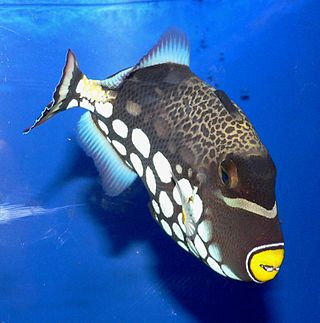
Balistoides is a genus of marine ray-finned fishes belonging to the family Balistidae, the triggerfishes. The triggerfishes in this genus are found in the Indo-Pacific region.
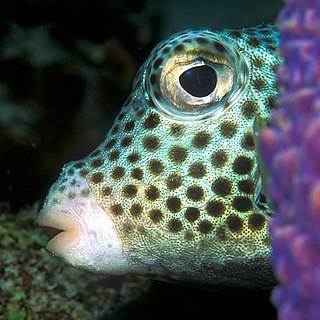
Lactophrys is a genus of marine ray-finned fishes belonging to the family Ostraciidae, the boxfishes. The boxfishes in this genus are found in the western Atlantic Ocean and are known as trunkfishes.

Lactoria is a genus of marine ray-finned fishes belonging to the family Ostraciidae, the boxfishes. The fishes in this genus are found in the Indo-Pacific, with one species extending into the southeastern Atlantic.
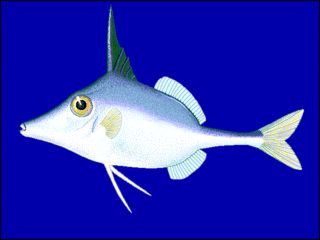
Triacanthus is a genus of marine ray-finned fish belonging to the family Triacanthidae, the triplespines or tripodfishes. The two species in this genus are found in the Indian Ocean and the western Pacific Ocean.
Mephisto is a genus of marine ray-finned fishes belonging to the family Triacanthodidae, the spikefishes. These fishes are found in the Indian Ocean.

Triacanthodes is a genus of marine ray-finned fishes belonging to the family Triacanthodidae, the spikefishes. These fishes are found found in the Indian and Pacific Oceans.
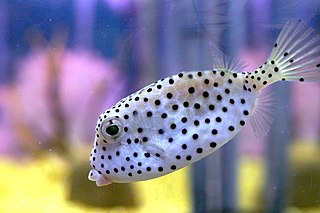
Ostracion rhinorhynchos, the horn-nosed boxfish or torpedo boxfish, is a species of ray-finned fish belonging to the family Ostraciidae, the boxfishes. This fish occurs in the Indo-West Pacific region.
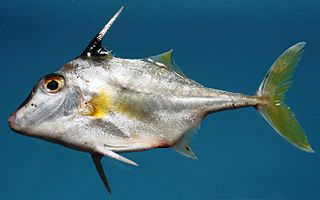
Triacanthus biaculeatus, also known as the short-nosed tripod fish, black-finned triple-spine, blacktail tripodfish, hollow-snouted tripodfish or silver tripodfish, is a species of marine ray-finned fish belonging to the family Triacanthidae, the triplespines or tripodfishes. This species is found in the Indo-West Pacific region.

Abalistes filamentosus, the hairfin triggerfish, is a species of marine ray-finned fish belonging to the family Balistidae, the triggerfishes. It is found in the Indo-Pacific Ocean and in subtropical waters. It lives in the Pelagic-Neritic zone of the ocean between 61–180 meters deep. It is harmless to humans.

The Shortnose boxfish is a species of marine ray-finned fish belonging to the family Ostraciidae, the boxfishes. This species is found in the Indian and Pacific Oceans.
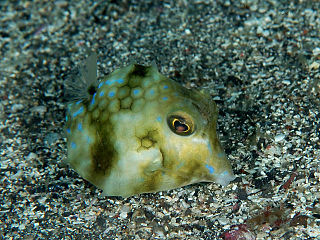
The triangular boxfish is a species of marine ray-finned fishes belonging to the family Ostraciidae, the boxfishes. The fishes in this genus are known as turretfishes and they are found in the Indian and western Pacific Oceans.

Lactophrys trigonus, the buffalo trunkfish or trunkfish, is a species of marine ray-finned fish belonging to the family Ostraciidae, the boxfishes. The buffalo trunkfish is found in the Western Atlantic Ocean.
Kentrocapros rosapinto, the basketfish, is a species of marine ray-finned fish belonging to the family Aracanidae, the temperate boxfishes or deepwater boxfishes. This fish is found in the Western Indian Ocean and in the southeastern Atlantic Ocean.

Ostracion cyanurus, the bluetail trunkfish, Arabian trunkfish or Red Sea boxfish, is a species of marine ray-finned fish belonging to the family Ostraciidae, the boxfishes. This species is found in the Western Indian Ocean.

Ostracion trachys, the rough boxfish or roughskin trunkfish, is a species of marine ray-finned fish belonging to the family Ostraciidae, the boxfishes. It is found in the Western Indian Ocean around the Mascarenes.

The smallspine turretfish is a species of marine ray-finned fish belonging to the family Ostraciidae, the boxfishes. This species is found in the Indo-Pacific region.


















